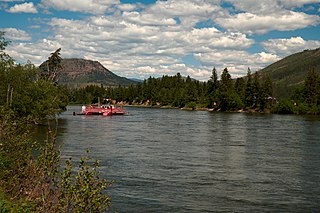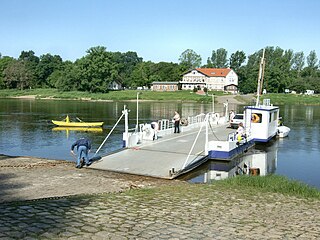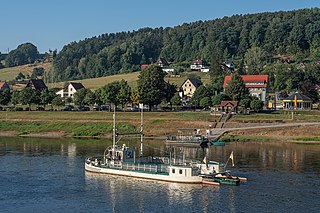
A reaction ferry is a cable ferry that uses the reaction of the current of a river against a fixed tether to propel the vessel across the water. Such ferries operate faster and more effectively in rivers with strong currents.

A reaction ferry is a cable ferry that uses the reaction of the current of a river against a fixed tether to propel the vessel across the water. Such ferries operate faster and more effectively in rivers with strong currents.
Some reaction ferries operate using an overhead cable suspended from towers anchored on either bank of the river at right angles to the current flow. A "traveller" with pulleys runs along this cable and is attached to the ferry with a tether rope. This can divide into a two-part bridle which defines the angle of the ferry to the current. Sometimes two pulleys and tethers are used. Sometimes a single tether is attached to a bar that can be swung from one side of the ferry to the other. This type also uses a rudder in order to set the angle of the ferry to the current flow from zero - it is then stationary - to the best angle for maximal crossing speed. Ferries without a rudder change the relative lengths of the bridle or multiple tethers in order to steer. The lateral force of the current moves the ferry across the river.
A now rare type of reaction ferry uses a submerged cable lying on the bottom across a river or tidal water. This can be a wire rope or a chain and is pulled to the surface by the ferry or its operator. It passes through moveable pulleys or belaying points whose location sets the ferry's angle. In order to set off, manual work is required to initially pull the cable and also to manoeuvre, especially during the turning of the tide. [1]
The ferry may consist of a single hull, or two pontoons with a deck bridging them. Some ferries carry only passengers, whilst others carry road vehicles, with some examples carrying up to 12 cars.

A reaction ferry operates as a sailing craft where the traveller pulleys represent the wheels of a land yacht and the moving fluid is the water current rather than the wind. In the case of a reaction ferry with an anchored tether, the analogy can also be to a kite. In both cases the ferry's hull itself represents a sail and is angled to the apparent water current in order to generate lift in the same way a sail is set at an angle to the apparent wind.
With an overhead cable stretched across a river at right angles to the current, the ferry is, in sailing terminology, sailing on a reach with the true current exactly at right angles to the direction of crossing. For the anchored-tether type ferry this is valid when the tether is parallel to the current, near the middle of crossing. In sailing, the speed is governed by the lift-to-drag ratios (L/D) of the sail and the hull including centerboard or keel and rudder. [2]
For reaction ferries, L/D ratios also apply except that one is very high, for example typically 30 for a traveller on a steel rope, as visible in aerial photographs, and the other can vary from low, e.g. 1-2 without a centerboard, to 3.5 with one. [3]
A diagram is shown which follows the standard force diagram for sailing. [3] [4] It is drawn with a traveller L/D of only about 6 in order to make it clearer. The ferry L/D is drawn at 1.5. The lift L acts at right angles to the direction of the apparent current, the vector sum of the true current and the current component due to the crossing speed. The drag D acts parallel to the apparent current. The vector sum of L and D is the resultant force R. This force can only exist because the tether exerts an opposed force of the same magnitude (see Newton's laws of motion), in this simplified two-dimensional projection of what is really a three-dimensional situation. R can be resolved in a drag component directly downstream and a component in the direction of crossing, the thrust T which drives the ferry. This is balanced by the opposing drag of the traveller pulleys. The amount of lift required is set by the angle of incidence of the ferry to the apparent current (here 10°), often done with a rudder (not shown).
In the figure the crossing speed is the same as the speed of the true current. With a centerboard or keel, the hull's L/D could increase several times. This would increase the crossing speed also several times, but according to the drag equation the forces increase with the square of the speed and put a great load particularly on the overhead cable. With the anchored-tether type ferry, such high speeds would be unobtainable because its tether drags in the water or is supported by buoys that do and this drag would also increase with the square of the speed.

At one time over 30 reaction ferries crossed the rivers of British Columbia, primarily the Fraser River and the Thompson River. Those still operating include:
In Quebec, the small Laval-sur-le-Lac–Île-Bizard Ferry operates seasonally across the Rivière des Prairies from Laval-sur-le-Lac to the Île Bizard.

A number of reaction ferries operate in Germany, particularly across the rivers Elbe and Weser. Between the 17th and 19th centuries, they were quite common on the Rhine. Currently operating ferries include:

The Traghetto di Leonardo is a historic reaction ferry across the Adda River at Imbersago. It is reputed to have been designed by Leonardo da Vinci. [6]


A number of reaction ferries operate:



Four passenger ferries cross the Rhine in Basel. [11] [12]
Three such ferries cross the Aare in Bern.
A small traditional ferry, the last on this river, crosses the Doubs. [13]

The Hampton Loade Ferry, which carried passengers only, crossed the River Severn at Hampton Loade in Shropshire until 2017. It was operated partly by the current and partly by punting.
Several reaction ferries crossed rivers in the Ozark Mountains of the central United States during the first half of the 20th century. The Akers Ferry across the Current River near Salem in Missouri remains in operation. Menor's Ferry in Jackson Hole, Wyoming, was a dual-pontoon reaction ferry built in the 1890s and operated until 1927. A replica was constructed by the National Park Service in 2009. [14] [15]

The Elbe is one of the major rivers of Western Europe. It rises in the Giant Mountains of the northern Czech Republic before traversing much of Bohemia, then Germany and flowing into the North Sea at Cuxhaven, 110 kilometres northwest of Hamburg. Its total length is 1,094 km (680 mi).
A ferry is a watercraft that carries passengers, and sometimes vehicles and cargo, across a body of water. A small passenger ferry with many stops, such as in Venice, Italy, is sometimes called a water taxi or water bus.

A cable ferry is a ferry that is guided across a river or large body of water by cables connected to both shores. Early cable ferries often used either rope or steel chains, with the latter resulting in the alternative name of chain ferry. Both of these were largely replaced by wire cable by the late 19th century.

Wisemans Ferry is a cable ferry across the Hawkesbury River in New South Wales, Australia. The ferry operates from the eponymous community of Wisemans Ferry on the south bank, to a point on the north bank downstream of the Hawkesbury River's confluence with the Macdonald River, connecting with the old Great North Road. The crossing has remained in use on its current site since 1829, making it the oldest ferry crossing still in operation in New South Wales, and possibly in Australia.
Elster is a village and a former municipality in Saxony-Anhalt, Germany located in Wittenberg district. Since 1 January 2011, it is part of the town Zahna-Elster. From 2005 until 2011 it belonged to the administrative municipality (Verwaltungsgemeinschaft) of Elbaue-Fläming, before 2005 it belonged to the administrative community of Elster-Seyda-Klöden.

Barby is a town in the Salzlandkreis district, in Saxony-Anhalt, Germany. It is situated on the left bank of the River Elbe, near the confluence with the Saale, approx. 25 km (16 mi) southeast of Magdeburg. Since an administrative reform of 1 January 2010 it comprises the former municipalities of the Verwaltungsgemeinschaft Elbe-Saale, except for Gnadau, that joined Barby in September 2010. The Barby Ferry, a reaction ferry across the Elbe, links Barby with Zerbst-Walternienburg.

Hampton Loade Ferry was a pedestrian cable ferry linking the villages of Hampton Loade and Hampton across the River Severn in the English county of Shropshire and providing a link to Hampton Loade village from Hampton Loade station on the heritage Severn Valley Railway, in Hampton village.

The Lytton Ferry is a cable ferry across the Fraser River in British Columbia, Canada. It is situated about 2.4 kilometres (1.5 mi) north of Lytton.

Big Bar Ferry is a cable ferry across the Fraser River in British Columbia, Canada. It is located about 60 kilometres (37 mi) north of the town of Lillooet and 72 kilometres (45 mi) west of Clinton. 6 km upstream from the ferry is French Bar Canyon, while downstream is High Bar Canyon . The ferry connects the dirt ranch road up the west side of the Fraser from Lillooet to Big Bar and Kostering, which connect via road to Jesmond and Big Bar Lake, and beyond to BC Highway 97.

The McLure Ferry is a cable ferry across the North Thompson River in British Columbia, Canada. It is situated about 43 kilometres (27 mi) north of Kamloops.

The Little Fort Ferry is a cable ferry across the North Thompson River in British Columbia, Canada. It is situated at Little Fort, about 93 kilometres (58 mi) north of Kamloops.

A ship mill, more commonly known as a boat mill, is a type of watermill. The milling and grinding technology and the drive (waterwheel) are built on a floating platform on this type of mill. Its first recorded use dates back to mid-6th century AD Italy.

The Westerhüsen Ferry is a cable ferry across the Elbe river in the city of Magdeburg in Saxony-Anhalt, Germany. The ferry links the districts of Westerhüsen, on the left bank, and Randau-Calenberge opposite.

The Sandau Ferry, also known as the Sandau Büttnershof Ferry, is a cable ferry across the Elbe river between Sandau and Büttnershof in Saxony-Anhalt, Germany.

The Barby Ferry, also known as the Ronney Barby Ferry, is a cable ferry across the Elbe river between Barby and Walternienburg in Saxony-Anhalt, Germany.

The Veckerhagen Ferry is a cable ferry across the Weser River in Germany. The ferry crosses between Veckerhagen, in Hesse, and Hemeln, in Lower Saxony. The crossing is located some 26 kilometres (16 mi) north of Kassel. The ferry takes automotive, bicycle and foot passengers.

The Coswig Ferry, also known as the Wörlitz Coswig Ferry, is a cable ferry across the Elbe river between Coswig and Wörlitz in Saxony-Anhalt, Germany. The ferry is owned by the municipality of Coswig.

The Dolní Žleb Ferry is a cable ferry across the Elbe river at Dolní Žleb in the Děčín District in the Ústí nad Labem Region of the Czech Republic.

The Rathen Ferry is a passenger cable ferry across the Elbe river at Rathen in Saxony, Germany. It connects Niederrathen, on the east bank, to Oberrathen, on the west bank. Kurort Rathen railway station, on the Dresden S-Bahn, is about 200 metres (660 ft) from the Oberrathen ferry terminal. The Niederrathen ferry terminal provides access to the famous Bastei cliffs, to the Amselsee lake, and the Felsenbühne Rathen outdoor theatre.

The Aken Ferry, also known as the Steutz Aken Ferry, is a cable ferry across the Elbe river between Aken and Steutz in Saxony-Anhalt, Germany.